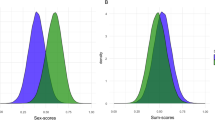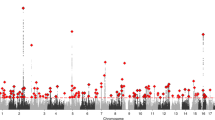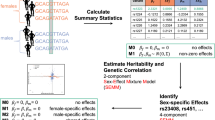Abstract
Males and females present differences in complex traits and in the risk of a wide array of diseases. Genotype by sex (GxS) interactions are thought to account for some of these differences. However, the extent and basis of GxS are poorly understood. In the present study, we provide insights into both the scope and the mechanism of GxS across the genome of about 450,000 individuals of European ancestry and 530 complex traits in the UK Biobank. We found small yet widespread differences in genetic architecture across traits. We also found that, in some cases, sex-agnostic analyses may be missing trait-associated loci and looked into possible improvements in the prediction of high-level phenotypes. Finally, we studied the potential functional role of the differences observed through sex-biased gene expression and gene-level analyses. Our results suggest the need to consider sex-aware analyses for future studies to shed light onto possible sex-specific molecular mechanisms.
This is a preview of subscription content, access via your institution
Access options
Access Nature and 54 other Nature Portfolio journals
Get Nature+, our best-value online-access subscription
$29.99 / 30 days
cancel any time
Subscribe to this journal
Receive 12 print issues and online access
$209.00 per year
only $17.42 per issue
Buy this article
- Purchase on Springer Link
- Instant access to full article PDF
Prices may be subject to local taxes which are calculated during checkout



Similar content being viewed by others
Data availability
This research was conducted using the UK Biobank Resource under project 788. Data from the GTEx project v.6p release was also employed. Protected genotype data were accessed via dbGaP and processed gene expression data were downloaded from the GTEx portal, which is openly available: https://gtexportal.org. The GIANT cohort’s summary statistics were employed to compare findings (openly available: https://portals.broadinstitute.org/collaboration/giant), as well as Pulit et al.’s summary statistics pertaining to a GIANT-UKB meta-analysis21 (openly available: https://github.com/lindgrengroup/fatdistnGWAS). The authors declare that the data supporting the findings of the present study are available within the paper and its supplementary information files. The GWAS summary statistics of both autosomal and X-chromosome variants from sex-stratified models are openly available from the University of Edinburgh DataShare repository within the following collection: https://datashare.ed.ac.uk/handle/10283/3908 (clinical binary traits https://doi.org/10.7488/ds/3046, nonclinical binary traits https://doi.org/10.7488/ds/3047, nonbinary traits https://doi.org/10.7488/ds/3048 and LogMM results https://doi.org/10.7488/ds/3049).
Code availability
We used DISSECT (v.1.15.2c, 24 May 2018, which is publicly available at http://www.dissect.ed.ac.uk under GNU Lesser General Public License v.3), PLINK (v.1.9 and v.2.0, freely available online at https://www.cog-genomics.org/plink2), BGENIX (v.1.0 freely available online at https://bitbucket.org/gavinband/bgen), LD score regression (v.1.0.1, freely available online at https://github.com/bulik/ldsc), MAGMA (v.1.06, freely available online at https://ctg.cncr.nl/software/magma), FUMA (freely available online at https://fuma.ctglab.nl), GCTA (v.1.91.4, freely available at https://cnsgenomics.com/software/gcta) and REGENIE (v.1.0.7, freely available online at https://github.com/rgcgithub/regenie/tree/v1.0.7-latest). Customized code created to perform the analysis is openly available (https://zenodo.org/record/4844680), with https://doi.org/10.5281/zenodo.4844680.
References
Ober, C., Loisel, D. A. & Gilad, Y. Sex-specific genetic architecture of human disease. Nat. Rev. Genet. 9, 911–922 (2008).
Weiss, L. A., Pan, L., Abney, M. & Ober, C. The sex-specific genetic architecture of quantitative traits in humans. Nat. Genet. 38, 218–222 (2006).
Mayne, B. T. et al. Large scale gene expression meta-analysis reveals tissue-specific, sex-biased gene expression in humans. Front. Genet. 7, 183 (2016).
Jansen, R. et al. Sex differences in the human peripheral blood transcriptome. BMC Genom. 15, 33 (2014).
Trabzuni, D. et al. Widespread sex differences in gene expression and splicing in the adult human brain. Nat. Commun. 4, 2771 (2013).
Kottgen, A. et al. Genome-wide association analyses identify 18 new loci associated with serum urate concentrations. Nat. Genet. 45, 145–154 (2013).
InanlooRahatloo, K. et al. Sex-based differences in myocardial gene expression in recently deceased organ donors with no prior cardiovascular disease. PLoS ONE 12, e0183874 (2017).
Mele, M. et al. The human transcriptome across tissues and individuals. Science 348, 660–665 (2015).
Gershoni, M. & Pietrokovski, S. The landscape of sex-differential transcriptome and its consequent selection in human adults. BMC Biol. 15, 7 (2017).
Guo, S. et al. Identification and analysis of the human sex-biased genes. Br. Bioinform. 19, 188–198 (2018).
Khramtsova, E. A., Davis, L. K. & Stranger, B. E. The role of sex in the genomics of human complex traits. Nat. Rev. Genet. 20, 173–190 (2019).
Rawlik, K., Canela-Xandri, O. & Tenesa, A. Evidence for sex-specific genetic architectures across a spectrum of human complex traits. Genome Biol. 17, 166 (2016).
Gilks, W. P., Abbott, J. K. & Morrow, E. H. Sex differences in disease genetics: evidence, evolution, and detection. Trends Genet. 30, 453–463 (2014).
Traglia, M. et al. Genetic mechanisms leading to sex differences across common diseases and anthropometric traits. Genetics 205, 979–992 (2017).
Ge, T., Chen, C.-Y., Neale, B. M., Sabuncu, M. R. & Smoller, J. W. Phenome-wide heritability analysis of the UK Biobank. PLoS Genet. 13, e1006711 (2017).
Yang, J. et al. Genome-wide genetic homogeneity between sexes and populations for human height and body mass index. Hum. Mol. Genet. 24, 7445–7449 (2015).
Stringer, S., Polderman, T. & Posthuma, D. Majority of human traits do not show evidence for sex-specific genetic and environmental effects. Sci. Rep. 7, 8688 (2017).
Vink, J. M. et al. Sex differences in genetic architecture of complex phenotypes? PLoS ONE 7, e47371 (2012).
Polderman, T. J. C. et al. Meta-analysis of the heritability of human traits based on fifty years of twin studies. Nat. Genet. 47, 702–709 (2015).
Winkler, T. W. et al. The influence of age and sex on genetic associations with adult body size and shape: a large-scale genome-wide interaction study. PLoS Genet. 11, e1005378 (2015).
Pulit, S. L. et al. Meta-analysis of genome-wide association studies for body fat distribution in 694,649 individuals of European ancestry. Hum. Mol. Genet. 28, 166–174 (2018).
Doring, A. et al. SLC2A9 influences uric acid concentrations with pronounced sex-specific effects. Nat. Genet. 40, 430–436 (2008).
Randall, J. C. et al. Sex-stratified genome-wide association studies including 270,000 individuals show sexual dimorphism in genetic loci for anthropometric traits. PLoS Genet. 9, e1003500 (2013).
Rask-Andersen, M., Karlsson, T., Ek, W. E. & Johansson, Å. Genome-wide association study of body fat distribution identifies adiposity loci and sex-specific genetic effects. Nat. Commun. 10, 339 (2019).
Dumitrescu, L. et al. Sex differences in the genetic predictors of Alzheimer’s pathology. Brain 142, 2581–2589 (2019); https://doi.org/10.1093/brain/awz206
Graham, S. E. et al. Sex-specific and pleiotropic effects underlying kidney function identified from GWAS meta-analysis. Nat. Commun. 10, 1847 (2019).
Hartiala, J. A. et al. Genome-wide association study and targeted metabolomics identifies sex-specific association of CPS1 with coronary artery disease. Nat. Commun. 7, 10558 (2016).
Beery, A. K. & Zucker, I. Sex bias in neuroscience and biomedical research. Neurosci. Biobehav. Rev. 35, 565–572 (2011).
Canela-Xandri, O., Law, A., Gray, A., Woolliams, J. A. & Tenesa, A. A new tool called DISSECT for analysing large genomic data sets using a Big Data approach. Nat. Commun. 6, 10162 (2015).
Yang, J., Zeng, J., Goddard, M. E., Wray, N. R. & Visscher, P. M. Concepts, estimation and interpretation of SNP-based heritability. Nat. Genet. 49, 1304–1310 (2017).
Bulik-Sullivan, B. et al. An atlas of genetic correlations across human diseases and traits. Nat. Genet. 47, 1236–1241 (2015).
Ni, G., Moser, G., Schizophrenia Working Group of the Psychiatric Genomics Consortium, Wray, N. R. & Lee, S. H. Estimation of genetic correlation via linkage disequilibrium score regression and genomic restricted maximum likelihood. Am. J. Hum. Genet. 102, 1185–1194 (2018).
Kolz, M. et al. Meta-analysis of 28,141 individuals identifies common variants within five new loci that influence uric acid concentrations. PLoS Genet. 5, e1000504 (2009).
Zhu, F. et al. Mutations in PMFBP1 cause acephalic spermatozoa syndrome. Am. J. Hum. Genet. 103, 188–199 (2018).
Mbatchou, J. et al. Computationally efficient whole-genome regression for quantitative and binary traits. Nat. Genet. https://doi.org/10.1038/s41588-021-00870-7 (2021).
Manolio, T. A. et al. Finding the missing heritability of complex diseases. Nature 461, 747–753 (2009).
de Leeuw, C. A., Mooij, J. M., Heskes, T. & Posthuma, D. MAGMA: generalized gene-set analysis of GWAS data. PLoS Comput. Biol. 11, e1004219 (2015).
Watanabe, K., Taskesen, E., van Bochoven, A. & Posthuma, D. Functional mapping and annotation of genetic associations with FUMA. Nat. Commun. 8, 1826 (2017).
Morgan, C. P. & Bale, T. L. Sex differences in microRNA regulation of gene expression: no smoke, just miRs. Biol. Sex. Differ. 3, 22 (2012).
Dimas, A. S. et al. Sex-biased genetic effects on gene regulation in humans. Genome Res. 22, 2368–2375 (2012).
Yao, C. et al. Sex- and age-interacting eQTLs in human complex diseases. Hum. Mol. Genet. 23, 1947–1956 (2014).
Kassam, I. et al. Autosomal genetic control of human gene expression does not differ across the sexes. Genome Biol. 17, 248 (2016).
Porcu, E. et al. The role of gene expression on human sexual dimorphism: too early to call. Preprint at bioRxiv https://doi.org/10.1101/2020.04.15.042986 (2020).
Bahram, S., Bresnahan, M., Geraghty, D. E. & Spies, T. A second lineage of mammalian major histocompatibility complex class I genes. Proc. Natl Acad. Sci. USA 91, 6259–6263 (1994).
Dunham, I. et al. An integrated encyclopedia of DNA elements in the human genome. Nature 489, 57–74 (2012).
Robinson, J. L. L. & Carroll, J. S. FoxA1 is a key mediator of hormonal response in breast and prostate cancer. Front. Endocrinol. 3, 68 (2012).
Li, Z., Tuteja, G., Schug, J. & Kaestner, K. H. Foxa1 and Foxa2 are essential for sexual dimorphism in liver cancer. Cell 148, 72–83 (2012); https://doi.org/10.1016/j.cell.2011.11.026
Sudlow, C. et al. UK Biobank: an open access resource for identifying the causes of a wide range of complex diseases of middle and old age. PLoS Med. 12, e1001779 (2015).
Canela-Xandri, O., Rawlik, K. & Tenesa, A. An atlas of genetic associations in UK Biobank. Nat. Genet. 50, 1593–1599 (2018).
Loh, P.-R., Kichaev, G., Gazal, S., Schoech, A. P. & Price, A. L. Mixed-model association for biobank-scale datasets. Nat. Genet. 50, 906–908 (2018).
Pirastu, N. et al. Genetic analyses identify widespread sex-differential participation bias. Nat. Genet. 53, 663–671 (2021).
ICD-10: International Statistical Classification of Diseases and Related Health Problems: Tenth Revision, 2nd edn (WHO, 2004).
Munoz, M. et al. Evaluating the contribution of genetics and familial shared environment to common disease using the UK Biobank. Nat. Genet. 48, 980–983 (2016).
Hansen, T. F., Pélabon, C. & Houle, D. Heritability is not evolvability. Evol. Biol. 38, 258 (2011).
Garcia-Gonzalez, F., Simmons, L. W., Tomkins, J. L., Kotiaho, J. S. & Evans, J. P. Comparing evolvabilities: common errors surrounding the calculation and use of coefficients of additive genetic variation. Evolution 66, 2341–2349 (2012).
Purcell, S. et al. PLINK: a tool set for whole-genome association and population-based linkage analyses. Am. J. Hum. Genet 81, 559–575 (2007).
Mason, S. J. & Graham, N. E. Areas beneath the relative operating characteristics (ROC) and relative operating levels (ROL) curves: statistical significance and interpretation. Q. J. R. Meteorol. Soc. 128, 2145–2166 (2002).
Fisher, R. A. Frequency distribution of the values of the correlation coefficient in samples from an indefinitely large population. Biometrika 10, 507 (1915).
Robin, X. et al. pROC: an open-source package for R and S+ to analyze and compare ROC curves. BMC Bioinform. 12, 77 (2011).
Carithers, L. J. & Moore, H. M. The Genotype-Tissue Expression (GTEx) project. Biopreserv. Biobank https://doi.org/10.1038/ng.2653 (2015).
Buniello, A. et al. The NHGRI-EBI GWAS catalog of published genome-wide association studies, targeted arrays and summary statistics 2019. Nucleic Acids Res. 47, D1005–D1012 (2019).
Lawrence, M. et al. Software for computing and annotating genomic ranges. PLoS Comput. Biol. 9, e1003118 (2013).
Kinsella, R. J. et al. Ensembl BioMarts: a hub for data retrieval across taxonomic space. Database 2011, bar030 (2011).
Consortium, G. T. et al. Genetic effects on gene expression across human tissues. Nature 550, 204–213 (2017).
Bernabeu, E. Sex differences in genetic architecture in UK Biobank—Code. Zenodo https://doi.org/10.5281/ZENODO.4844680 (2021).
Acknowledgements
This research was funded by the BBSRC through program grants (nos. BBS/E/D/10002070 (to A. Tenesa), BBS/E/D/30002275 (to A. Tenesa) and BBS/E/D/30002276 (to A. Tenesa, J.P., K.R. and A. Talenti)); MRC research grants (nos. MR/P015514/1 (to A. Tenesa) and MR/R025851/1 (to A. Tenesa and O.C.-X.)); HDR-UK award (no. HDR-9004 (to A. Tenesa)); and the Roslin Foundation’s Steve Bishop PhD Fellowship (to E.B.). This research has been conducted using the UK Biobank Resource under project 788.
Author information
Authors and Affiliations
Contributions
A. Tenesa conceived the study. A. Tenesa, O.C.-X., K.R. and E.B. designed the genetic architecture, prediction, masking and eQTL analyses. A. Talenti and J.P. designed the gene-level analyses. O.C.-X., K.R. and E.B. pre-processed the data and conducted modeling. E.B. conducted the statistical analyses and prepared the initial manuscript. All authors contributed and commented on the development of the manuscript.
Corresponding author
Ethics declarations
Competing interests
The authors declare no competing interests.
Additional information
Peer review information Nature Genetics thanks the anonymous reviewers for their contribution to the peer review of this work. Peer reviewer reports are available.
Publisher’s note Springer Nature remains neutral with regard to jurisdictional claims in published maps and institutional affiliations.
Extended data
Extended Data Fig. 1 Genetic and residual variance fold differences between the sexes.
Barplot of log2 fold difference in variance between males and females for binary (top) and non-binary (bottom) traits with a significantly different heritability between the sexes at a q < 0.05 threshold. Pink bars represent fold change between the sexes in genetic variance, and blue bars represent fold change between the sexes in residual variance. Fold change is calculated as log2(male variance/female variance), thus positive fold change = larger variance in males, negative fold change = larger variance in females.
Extended Data Fig. 2 Comparison of genetic variance and evolvability estimates between the sexes.
Top plots: scatterplots comparing male genetic variance to female genetic variance for binary (left) and non-binary (right) traits. Bottom plots: scatterplots comparing male evolvability to female evolvability for binary (left) and non-binary (right) traits. Each point represents a trait, and pink points indicate traits for which the genomic parameter considered (genetic variance, evolvability) between the sexes is significantly different (q < 0.05, see Methods). Basal metabolic rate was removed as an outlier.
Extended Data Fig. 3 Genetic correlations across studies.
Barplot comparing genetic correlation estimates from this effort to the literature for several non-binary traits (‘WHR’: waist-hip circumference ratio, ‘Body Fat %’: body fat percentage, ‘BMI’: body-mass index, ‘WC’: waist circumference, ‘HC’: hip circumference, and ‘Height’: standing height). Height of bar indicates genetic correlation estimate (rg), different colors corresponding to different publications, as represented in legend by surname of first author12,14,16 and the values of which, are shown in Supplementary Table 2. Error bars represent 95% confidence intervals of rg estimates (rg + /−1.96SErg).
Extended Data Fig. 4 Distribution of sdSNPs across the genome.
Manhattan plot of number of sdSNPs (p < 1 × 10−8, two-sided t-test, see Methods) per genomic position, each point representing a genetic variant, and its height the number of traits it affects in a sexually different manner, for (a) non-binary traits and (b) binary traits.
Extended Data Fig. 5 Distributions of potentially masked SNPs.
For binary (left) and non-binary (right) traits with at least one potentially masked variant: (a) histogram of number of masked genetic variants, (b) histogram of proportion of masked variants that presented opposite sign effects between the sexes, (c) histogram of proportion of masked SNPs that were found to possess significantly different genetic effects between the sexes (two-sided t-test, p < 1 × 10−8 threshold, see Methods) and (d) histogram of the proportion of lead sdSNPs that were found to be masked.
Extended Data Fig. 6 Comparison of number of lead sdSNPs to number of masked variants.
For binary (left) and non-binary (right) traits with at least one sdSNP and one potentially masked variant, shown is a scatterplot of number of lead sdSNPs against number of potentially masked variants (p < 1 × 10−8, and LD clumped within sex, see Methods).
Extended Data Fig. 7 Gene-set enrichment heatmap.
Heatmap with hierarchical clustering of FUMA set enrichment -log10 q-values for 251 gene sets that were found to be significantly differentially enriched between males and females (Fisher’s exact test q < 0.05), as well as significantly differentially enriched to GWAS background genes (Fisher’s exact test q < 0.05). x-axis corresponds to male or female dominant genes (see Methods) for different traits, and y axis to gene sets. Color within plot represents scaled -log10 q-value of enrichment, and ‘Sex’ horizontal column indicates the sex in which the genes considered are dominant (pink for females, and blue for males).
Extended Data Fig. 8 Sex-biased eQTL plot for rs56705452.
Relationship of genotype at variant rs56705452 with the expression of the transcript ENSG00000204520.8 in muscle skeletal tissue, for males (pink) and females (blue). Each point represents an individual, the x-axis its genotype at the considered variant, and the y-axis gene expression levels for the considered transcript.
Supplementary information
Supplementary Information
Supplementary Methods, Results, Figs. 1–9 and captions for Supplementary Tables 1–24.
Supplementary Tables
Supplementary Tables 1–24. Captions for each table included in Supplementary Note.
Rights and permissions
Springer Nature or its licensor (e.g. a society or other partner) holds exclusive rights to this article under a publishing agreement with the author(s) or other rightsholder(s); author self-archiving of the accepted manuscript version of this article is solely governed by the terms of such publishing agreement and applicable law.
About this article
Cite this article
Bernabeu, E., Canela-Xandri, O., Rawlik, K. et al. Sex differences in genetic architecture in the UK Biobank. Nat Genet 53, 1283–1289 (2021). https://doi.org/10.1038/s41588-021-00912-0
Received:
Accepted:
Published:
Issue Date:
DOI: https://doi.org/10.1038/s41588-021-00912-0
This article is cited by
-
A method to estimate the contribution of rare coding variants to complex trait heritability
Nature Communications (2024)
-
Sex-specific genetic architecture of blood pressure
Nature Medicine (2024)
-
Sex differences in energy metabolism: natural selection, mechanisms and consequences
Nature Reviews Nephrology (2024)
-
Sex differences in DNA methylation across gestation: a large scale, cross-cohort, multi-tissue analysis
Cellular and Molecular Life Sciences (2024)
-
A roadmap for sex- and gender-disaggregated health research
BMC Medicine (2023)



